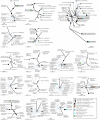Yeast forms dominate fungal diversity in the deep oceans
- PMID: 17939990
- PMCID: PMC2293941
- DOI: 10.1098/rspb.2007.1067
Yeast forms dominate fungal diversity in the deep oceans
Abstract
Fungi are the principal degraders of biomass in most terrestrial ecosystems. In contrast to surface environments, deep-sea environmental gene libraries have suggested that fungi are rare and non-diverse in high-pressure marine environments. Here, we report the diversity of fungi from 11 deep-sea samples from around the world representing depths from 1,500 to 4,000 m (146-388 atm) and two shallower water column samples (250 and 500m). We sequenced 239 clones from 10 fungal-specific 18S rRNA gene libraries constructed from these samples, from which we detected only 18 fungal 18S-types in deep-sea samples. Our phylogenetic analyses show that a total of only 32 fungal 18S-types have so far been recovered from deep-sea habitats, and our results suggest that fungi, in general, are relatively rare in the deep-sea habitats we sampled. The fungal diversity detected suggests that deep-sea environments host an evolutionarily diverse array of fungi dominated by groups of distantly related yeasts, although four putative filamentous fungal 18S-types were detected. The majority of our new sequences branch close to known fungi found in surface environments. This pattern contradicts the proposal that deep-sea and hydrothermal vent habitats represent ancient ecosystems, and demonstrates a history of frequent dispersal between terrestrial and deep-sea habitats.
Figures





References
-
- Adl S.M, et al. The new higher level classification of eukaryotes with emphasis on the taxonomy of protists. J. Eukaryot. Microbiol. 2005;52:399–451. doi:10.1111/j.1550-7408.2005.00053.x - DOI - PubMed
-
- Altschul S.F, Gish W, Miller W, Myers E.W, Lipman D.J. Basic local alignment search tool. J. Mol. Biol. 1990;215:403–410. - PubMed
-
- Amato A, Kooistra W.H, Ghiron J.H, Mann D.G, Proschold T, Montresor M. Reproductive isolation among sympatric cryptic species in marine diatoms. Protist. 2007;158:193–207. doi:10.1016/j.protis.2006.10.001 - DOI - PubMed
-
- Baldauf S.L. A search for the origins of animals and fungi: comparing and combining molecular data. Am. Nat. 1999;154:178–188. doi:10.1086/303292 - DOI - PubMed
-
- Bass D, Cavalier-Smith T. Phylum-specific environmental DNA analysis reveals remarkably high global biodiversity of Cercozoa (Protozoa) Int. J. Syst. Evol. Microbiol. 2004;54:2393–2404. doi:10.1099/ijs.0.63229-0 - DOI - PubMed
Publication types
MeSH terms
Substances
LinkOut - more resources
Full Text Sources
Medical
Molecular Biology Databases
Research Materials
Miscellaneous
